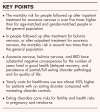Review of the burden of eating disorders: mortality, disability, costs, quality of life, and family burden
- PMID: 32796186
- PMCID: PMC7575017
- DOI: 10.1097/YCO.0000000000000641
Review of the burden of eating disorders: mortality, disability, costs, quality of life, and family burden
Abstract
Purpose of review: To review the recent literature on the burden of eating disorders in terms of mortality, disability, quality of life, economic cost, and family burden, compared with people without an eating disorder.
Recent findings: Estimates are that yearly over 3.3 million healthy life years worldwide are lost because of eating disorders. In contrast to other mental disorders, in anorexia nervosa and bulimia nervosa years lived with disability (YLDs) have increased. Despite treatment advances, mortality rates of anorexia nervosa and bulimia nervosa remain very high: those who have received inpatient treatment for anorexia nervosa still have a more than five times increased mortality risk. Mortality risks for bulimia nervosa, and for anorexia nervosa treated outside the hospital, are lower but still about twice those of controls. In people with an eating disorder, quality of life is reduced, yearly healthcare costs are 48% higher than in the general population, the presence of mental health comorbidity is associated with 48% lower yearly earnings, the number of offspring is reduced, and risks for adverse pregnancy and neonatal outcomes are increased.
Summary: People with a current or former eating disorder are at risk of increased mortality, high YLD rates, a reduced quality of life, increased costs, and problems with childbearing.
Conflict of interest statement
There are no conflicts of interest.
References
-
- Treasure J, Duarte TA, Schmidt U. Eating disorders. Lancet 2020; 395:899–911. - PubMed
-
- Svaldi J, Schmitz F, Baur J, et al. Efficacy of psychotherapies and pharmacotherapies for bulimia nervosa. Psychol Med 2019; 49:898–910. - PubMed
-
- Peat CM, Berkman ND, Lohr KN, et al. Comparative effectiveness of treatments for binge-eating disorder: systematic review and network meta-analysis. Eur Eat Disord Rev 2017; 25:317–328. - PubMed
-
- van den Berg E, Houtzager L, de Vos J, et al. Meta-analysis on the efficacy of psychological treatments for anorexia nervosa. Eur Eat Disord Rev 2019; 27:331–351. - PubMed
Publication types
MeSH terms
LinkOut - more resources
Full Text Sources
Medical
Research Materials


